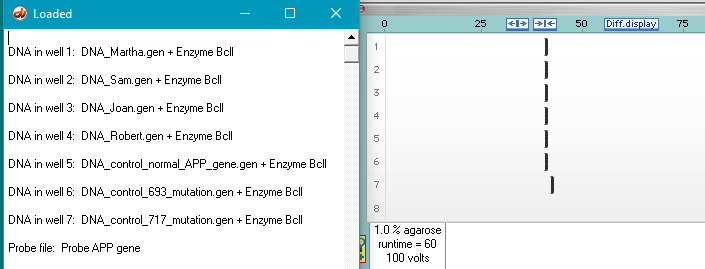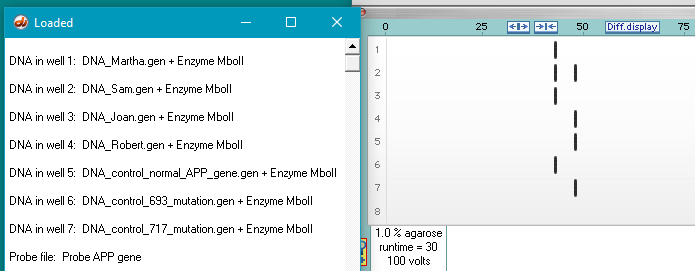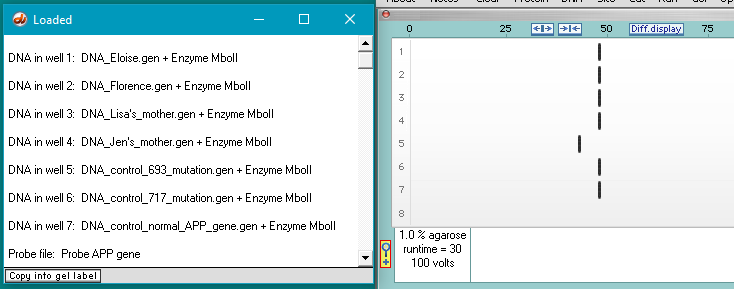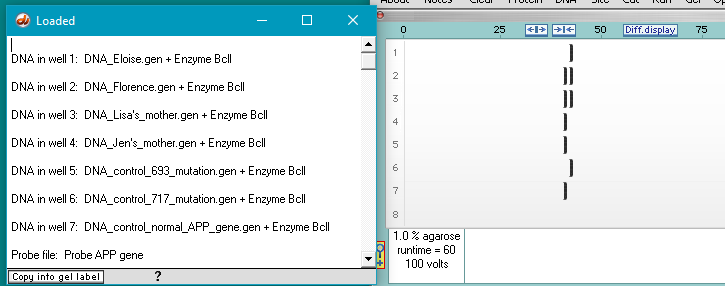Mutation/technique illustrated
Point mutations resulting in loss (mutation 693) or gain (mutation 717) of restriction site detected by Southern blotting and RFLP; 693 mutation results in a larger Mbo I fragment; 717 mutation results in a smaller Bcl I fragment. Note that small fragments are produced, so an agarose concentration of 2.0% was used (you could also decrease run times).
The DNA sequence files are from the human APP gene, GenBank accession number A33293, 2265 bp. Mutated sequence files were created by introducing point mutations at codons 693 (G to C) and 717 (G to A).
Reference: Kamino, K. et al. Am. J. Hum. Genet. 51:998-1014, 1992.
Case A:
Martha, age 71, has been exhibiting increasingly severe symptoms of senile dementia and has been hospitalized for testing. She is in good health otherwise. Her three children – Sam (age 43), Joan (age 41) and Robert (age 38) – want to find out the cause of the dementia and determine the prognosis for Martha’s future condition. They are also concerned that Martha may have a form of familial Alzheimer’s disease and want to know if they are at risk. The physician decides initially to test Martha for two mutations, 693 Gly and 717 Ile, in the amyloid precursor protein (APP) gene which are associated with inherited Alzheimer’s disease.

None of the family members have the 717 mutation (no gain of Bcl site).

- Martha (mother) – homozygous 693 mutation
- Sam (son)- heterozygous 693 mutation (possible increased risk)
- Joan (daughter) – homozygous 693 mutation (definite increased risk)
- Robert (son) – homozygous normal
- Control normal APP gene
- Control with 693 mutation
- Control with 717 mutation
Case B:
Lisa, age 17, and her cousin Jen age 18, were half-listening to music in the den and half-listening to their mothers discuss Grandma Eloise and her older sister Florence. Lisa and Jen loved Eli and Flo dearly but even they could tell something wasn’t quite right about their increasingly odd behavior. The teens moved into the kitchen to join the conversation. “Is Grandma’s erratic behavior and forgetfulness Alzheimer’s or just senile dementia commonly associated with old age?” They decide to talk to Eloise and Florence about DNA testing. The mothers also wonder about their risk for Alzheimer’s disease and decide to be tested.

None of the family members have the 693 mutation (no loss of MboII site).

- Eloise (grandmother) – homozygous 717 mutation (definite increased risk)
- Florence (Eloise’s older sister) – heterozygous 717 mutation (possible increased risk)
- Lisa’s mother – heterozygous 717 mutation
- Jen’s mother – homozygous non-mutated
- Control with 693 mutation
- Control with 717 mutation
- Control normal APP gene